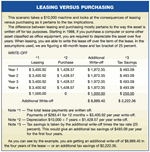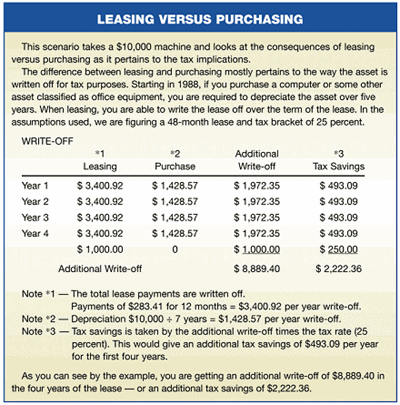Why You Should Consider Leasing Equipment for Your Shop
By taking advantage of leasing options, moldmakers can invest in new and upgraded equipment now.
Have you ever decided against buying new equipment because you thought your company couldn't afford it? Have you wanted to upgrade your operation, but weren't sure exactly what equipment would work best? If you've found yourself in either of these situations, equipment leasing can come to the rescue. Leasing is often easier and quicker than purchasing, allowing many companies to acquire equipment they need today, rather than waiting until later or borrowing capital from a bank to make a large purchase. In 2003, U.S. businesses spent $668 billion on productive assets, with 31 percent—$208 billion—going toward equipment leasing.
Leasing Options
Leasing new or used equipment for up to $75,000 usually involves completing a one-page application. In most cases, a decision on the lease is made within 24 hours, but some decisions are made in as little as eight hours. Documents are sent to the buyer (lessee), signed, and then returned to the funding source (lessor). The equipment is received and the lease payments start. A standard equipment lease term is usually 60 months. Some leases, however, are for as short as 12-months, while 72- to 84-month leases are sometimes available to a credit-worthy lessee.
Some typical lease program terms include the following:
- Standard fixed monthly payment—Zero payments for 90 days, seasonal; followed by a step-up rate (low at first, then increasing).
- 6x$99 program—Six payments of $99, then a set payment, and others upon request.
- Pre-funding—A vendor can be given up to 50 percent of the price of the equipment before it is built, while the lessee only puts up the deposit payments required to start the lease. When the equipment is delivered, the vendor gets paid the balance due. This program satisfies all the parties involved, but the lessee gets the greatest benefit as a result of getting the equipment it wanted without having to pay a large deposit up front. Should the lessee wish to upgrade equipment, this program also works well. New, state-of-the-art equipment can replace an older piece in the plant very easily. Upon approval, the funding source pays off the remaining balance of the older piece, and applies that balance to the cost of the new equipment. The shop now has new, modern equipment, without having to be concerned about selling the older piece.
- Sale/leaseback—This program is for lessee-owned equipment. The funding source buys the equipment from the lessee and leases it back. This program is normally a 36-month lease with a $1 buy-out option, which transfers the ownership of the equipment to the lessee at the end of the lease term. A sale/leaseback can help raise cash without affecting a line of credit with a bank.
Leasing terms are most often 12, 24, 36, 48 or 60 months, while end-of-lease payment options are usually either $1, 10 percent of the original lease amount, or fair market value (FMV). FMV option is based on the value of the equipment at the end of lease term. If equipment has a high value, the buy-out would be commensurately high (possibly more than 10 percent). The end-of-lease payment helps determine the monthly lease payments, with the highest lease payments being tied to the $1 option, and the lowest monthly payments coming with FMV option. Leases can be structured so that all payments are 100 percent tax deductible. An accountant can help determine the best structure for your business (see Finding an Accountant Sidebar).
Approvals
Most new or used equipment and rolling stock (trucks, trailers, tractors) can be leased. The length of time a company has been in business is critical in obtaining leasing approval. An established company (in business for two years or more) has a much better chance of obtaining a quick approval. Companies in business less than a year can sometimes get approved for equipment leases, but lessors may require more than a one-page credit application. Startup companies will not usually be approved for $25,000 or more without additional collateral available, such as real estate, CDs, etc.
Leasing provides a hedge against inflation, but also allows businesses the opportunity to invest in the equipment that may have not been able to obtain in the past (see Figure 1, below). By providing 100 percent financing, leasing also frees up capital for much needed research and development, which will be necessary for businesses to compete effectively in this growing economy.
| Figure 1: Leasing Versus Purchasing An example of leasing versus purchasing: This scenario takes a $10,000 machine and looks at the tax implications of lease versus purchase |
||||
|
WRITE-OFF
|
||||
| *1 | *2 | Additional | *3 | |
| Leasing | Purchase | Write-off | Tax Savings | |
| Year 1 | $3,400.92 | $1,428.57 | $1,972.35 | $493.09 |
| Year 2 | $3,400.92 | $1,428.57 | $1,972.35 | $493.09 |
| Year 3 | $3,400.92 | $1,428.57 | $1,972.35 | $493.09 |
| Year 4 | $3,400.92 | $1,428.57 | $1,972.35 | $493.09 |
| $1,000.00 | -0- | $1,000.00 | $250.00 | |
| Additional Write-off | $8,889.40 | $2,222.36 | ||
|
Note * 1—The total lease payments are written off. Payments of $283.41 for 12 months = $3,400.92 per year write-off. Note * 2—Depreciation $10,000 ¸ 7 years = $1,428.57 per year write-off. Note * 3—Tax savings is taken by the additional write-off times tax rate (25 percent). This would give the additional tax savings of $493.09 per year for the first four years. As you can see, you are getting an additional write-off of $8,889.40 in the four years of the lease—or an additional tax savings of $2,222.36. The difference between leasing and purchasing mostly pertains to the way the asset is written off for tax purposes. Starting in 1988, if you purchase a computer or some other asset classified as office equipment, you are required to depreciate the asset over five years. When leasing, you are able to write the lease off over the term of the lease. In the assumptions used, a 48-month lease and tax bracket of 25 percent is figured. |
||||
Related Content
Making Quick and Easy Kaizen Work for Your Shop
Within each person is unlimited creative potential to improve shop operations.
Read MoreHow to Improve Your Current Efficiency Rate
An alternative approach to taking on more EDM-intensive work when technology and personnel investment is not an option.
Read MoreOEE Monitoring System Addresses Root Cause of Machine Downtime
Unique sensor and patent-pending algorithm of the Amper machine analytics system measures current draw to quickly and inexpensively inform manufacturers which machines are down and why.
Read MoreTransforming Moldmaking into Digital Industrial Manufacturing
Moldmaking and digitalization is at the core of this global industrial manufacturing company’s consolidation and diversification plan.
Read MoreRead Next
Equipment Leasing: A Popular Alternative to Buying
Leasing equipment provides moldmakers with more purchasing opportunities during tough financial times.
Read MoreReasons to Use Fiber Lasers for Mold Cleaning
Fiber lasers offer a simplicity, speed, control and portability, minimizing mold cleaning risks.
Read MoreAre You a Moldmaker Considering 3D Printing? Consider the 3D Printing Workshop at NPE2024
Presentations will cover 3D printing for mold tooling, material innovation, product development, bridge production and full-scale, high-volume additive manufacturing.
Read More







_300x250 3.png;maxWidth=300;quality=90)




.jpg;maxWidth=300;quality=90)












